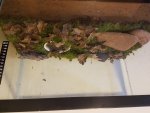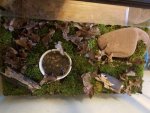bhill368
New member
- Joined
- Oct 20, 2017
- Messages
- 44
- Reaction score
- 2
- Points
- 0
- Location
- Oshkosh, WI
- Country
- United States
Hey All,
I have been learning about herps for a long time now and have taken a special liking to Caudates. That being said, I have obtained a decent sized Blue Spotted Salamander (possibly a hybrid) and set up a home for them. Can you give me any pointers off of what I have done so far?
They are set up in a 30 gallon tank with a layer of larger rocks for drainage at the bottom, a layer of loamy sand soil on top of that, and leaves as a substrate on top ( I boiled these to cleanse them). I have a dish that I fill with new water frequently. Hiding places include some small logs and a sturdy rock formation. I wanted to make it as similar to the habitat I found it in. I am using spring bottled water. I plan on switching to well water.
For a diet, I haven't had much luck on feeding so far. However, I have noticed some disappearance of inverts such as snails, isopods, and earthworms; as days have gone by. I think they prefer hunting their own food.
Let me know what you guys think! I will attach some pictures once I have some!
Cheers!
I have been learning about herps for a long time now and have taken a special liking to Caudates. That being said, I have obtained a decent sized Blue Spotted Salamander (possibly a hybrid) and set up a home for them. Can you give me any pointers off of what I have done so far?
They are set up in a 30 gallon tank with a layer of larger rocks for drainage at the bottom, a layer of loamy sand soil on top of that, and leaves as a substrate on top ( I boiled these to cleanse them). I have a dish that I fill with new water frequently. Hiding places include some small logs and a sturdy rock formation. I wanted to make it as similar to the habitat I found it in. I am using spring bottled water. I plan on switching to well water.
For a diet, I haven't had much luck on feeding so far. However, I have noticed some disappearance of inverts such as snails, isopods, and earthworms; as days have gone by. I think they prefer hunting their own food.
Let me know what you guys think! I will attach some pictures once I have some!
Cheers!


